LettsGroup HQ
LettsGroup had a busy January extending the AI VentureFactory with added features, onboarding processes and pricing plans for new users, while also migrating its venture building process, Innov@te, to a more advanced platform, including a wiki-type system with AI. The team continue to extend the installed AI apps and infrastructure, while adding more connectors across core business processes - getting to a level of automation that can fundamentally alter venture-building economics. The power of the AI VentureFactory will be further tested this year as LettsGroup's more developed 'branded ventures' begin recruiting dedicated, specialist leaders to take them beyond startup, through scale-up, with the AI VentureFactory acting as the bridge from the first-start team to the scale-up team.
LettsNews
LettsNews launched in beta last week offering 'newsroom tech for everyone' . It had a strong first week with a number of businesses signing up. Alongside its fully featured web app, which is now available to everyone, LettsNews is adding mobile apps for Android and Apple devices in the coming weeks. The mediatech Cloud software company offers 4 paid single user subscription plans, and will be adding a Company plan. The platform adopts a viral growth model as users invite co-workers, freelancers and agencies to their LettsNews Teams to share news items and stories, gathering inputs, copy edits and sign-off's for stories prior to release with LettsNews' auto-distribution tech. Any journalist, writer, content manager or PR can now sign up to LettsNews' web app at LettsNews.com.
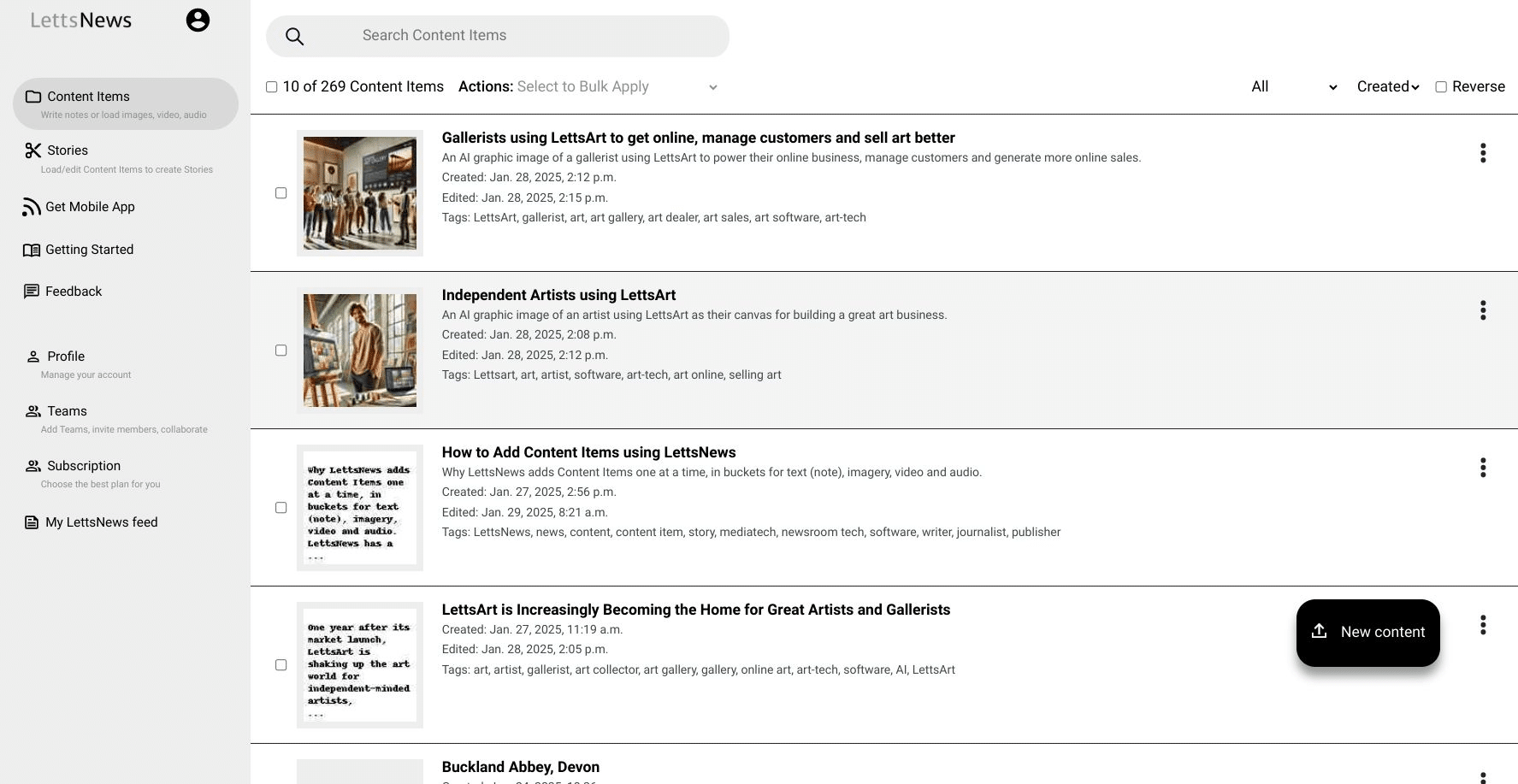
LettsCore
LettsCore, the web3 distributed media platform, started building its full commercial website ready for market launch later in Q1. The team also completed the platform's subscription plans and billing mechanisms with a pricing model that reflects the underlying economics of web3 - similar to other leading blockchain platforms. They have also implemented individual subscription wallets for every subscriber so their accounts can be auto topped-up following subscription payment and one-off credit purchases. The platform offers flexible pricing with 3 tiers for individuals, plus a company plan with secure, managed top-up for higher levels of activity / content and larger teams. This work continues through February delivering integrated subscription / top-up directly in the SaaS portal. Further to this the team implemented NFT minting and auto-distribution to Magic Eden's NFT Marketplace - a leading marketplace for Solana NFT content.
Want to escape the city? Book your 2025 company retreat or family break today at LettsRetreat.com.
LettsArt
LettsArt now has over 800 artist and art galleries using its subscription based, no-code AI software platform. A year after its market launch LettsArt is increasingly establishing itself as the all-in-one platform for artists and gallerists. In conventional art marketplaces, artists often struggle to stand out and connect directly with potential buyers. LettsArt turns this model on its head by providing each artist or gallerist with their own independent online gallery. From managing and distributing art to coordinating sales and managing collectors, LettsArt consolidates all of these once-siloed tasks into a single, streamlined dashboard. It's early validation with emerging artists will be extended in 2025 to higher value customers including professional studios, commercial galleries and art dealers.

EA Global AI
EA Global AI, which pioneers 'autofill' technology for company reporting, had their busiest month yet in January, with 2 enterprise customers, Hogan Lovells and Novartis, and 5 SMEs entering trials. Another 7 companies will kick off trials in February. On top of this, EA was featured in Asia Media’s ESG Investor publication. The senior team uses LettsGroup's AI VentureFactory to automate and accelerate processes, currently focused on organic and content marketing (with LettsNews in the stack) while also streamlining its SME onboarding, aiming to complete this in Q1, to increase capacity and confidently acquire smaller customers at scale and with lower friction.
LettsSafari
LettsSafari enjoyed a large jump in subscribers over the Christmas period and into January. This pioneering rewilding and nature restoration platform now boasts many known wildlife and conservation experts and influencers as subscribers, which should serve it well as it starts to extend its reach and capabilities. It has exciting plans for 2025. For any land owner or wildlife enthusiast that dreams of building their own mini rewilding safari park - here's how!
Other LettsGroup Ventures
We highlight just a few of our ventures in each monthly edition of The LettsGroup NewsFlash. To explore other LettsGroup ventures go to LettsGroup/ventures.
A rare bit of good news for journalists, an ambitious news publishing system from the LettsGroup stable went live today. It's called LettsNews and it describes itself as "'Newsroom tech for everyone". The British startup wants to reduce the cost and time taken to gather, publish and deliver news in the increasingly fragmented and real-time news industry. It could be a boon for overly stretched, under-staffed news rooms, and the growing number of freelance and self-employed journalists, writers and PR's.
Today LettsNews launched its cloud software platform for ever increasing news gatherers, commentators, freelancers and PR's that are looking for a better and more efficient way to gather, build and distribute the news. Their web app can be accessed from a laptop, PC or Mac and the all-in-one system can give any writer or PR a fully fledged newsroom in the Cloud. Mobile apps will also be available soon for work in the field.
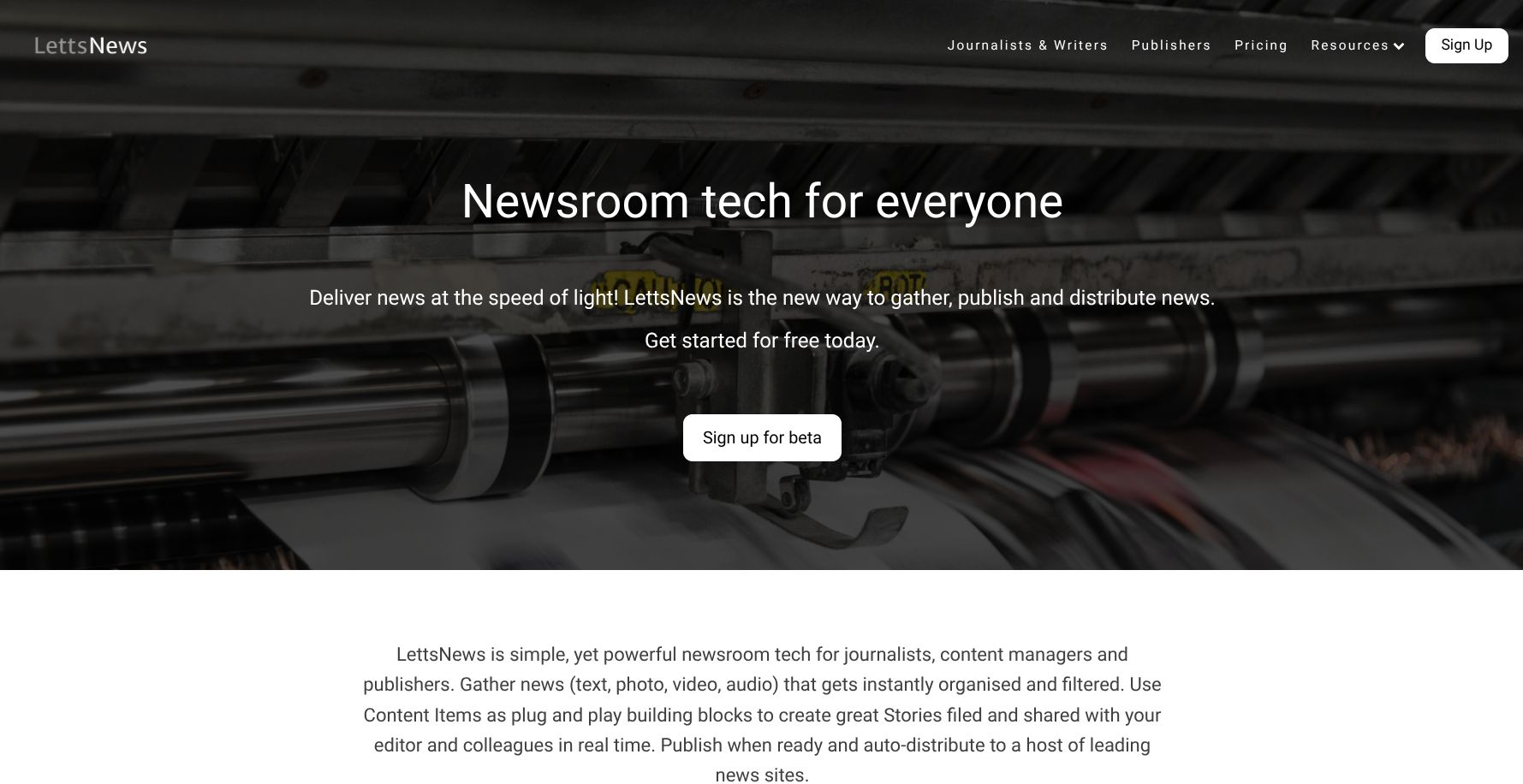
More than ever, newswriters are freelancers, independents and even citizens, but their tools for news gathering are rudimentary or wildly expensive. They write in MS Word or Google Docs, they use their phones for photos and videos. They publish their news into proprietary systems like WordPress or WiX, Substack or Medium, X or Bluesky, one at a time - cutting and pasting, at best, each time.
From the family that invented the diary, LettsNews is a slick, cost effective, all-in-one news gathering, publishing and distribution system designed to streamline this fragmented industry and the digital age. When you write in LettsNews, it automatically makes HTML news pages ready for global distribution. Images, video and audio can be cropped and basic-edited in the app, in the field. And its entire approach is quite revolutionary - adding individual Content Items (text, image, video, audio) - one at a time.

It's object-oriented programming but for content! Each Content Item you load gets tagged, sorted and organised ready for you to drag and drop into news stories. As your library of Content Items grows, your ability to instantly create news stories multiplies.
While LettsNews users focus on adding new Content Items, the software can take care of the rest - from story building, to team collaboration, editing, auto-distribution and even auto-promotion of the distributed stories. With LettsNews each News Item component gets dragged and dropped into a News Story and can be shared with collaborators in virtual teams, supported by version tracking and sign off. Teams can be added for each publication, project or work stream, whether it's a company blog, journalist's Medium page, a small publication's site, investor comms or more.
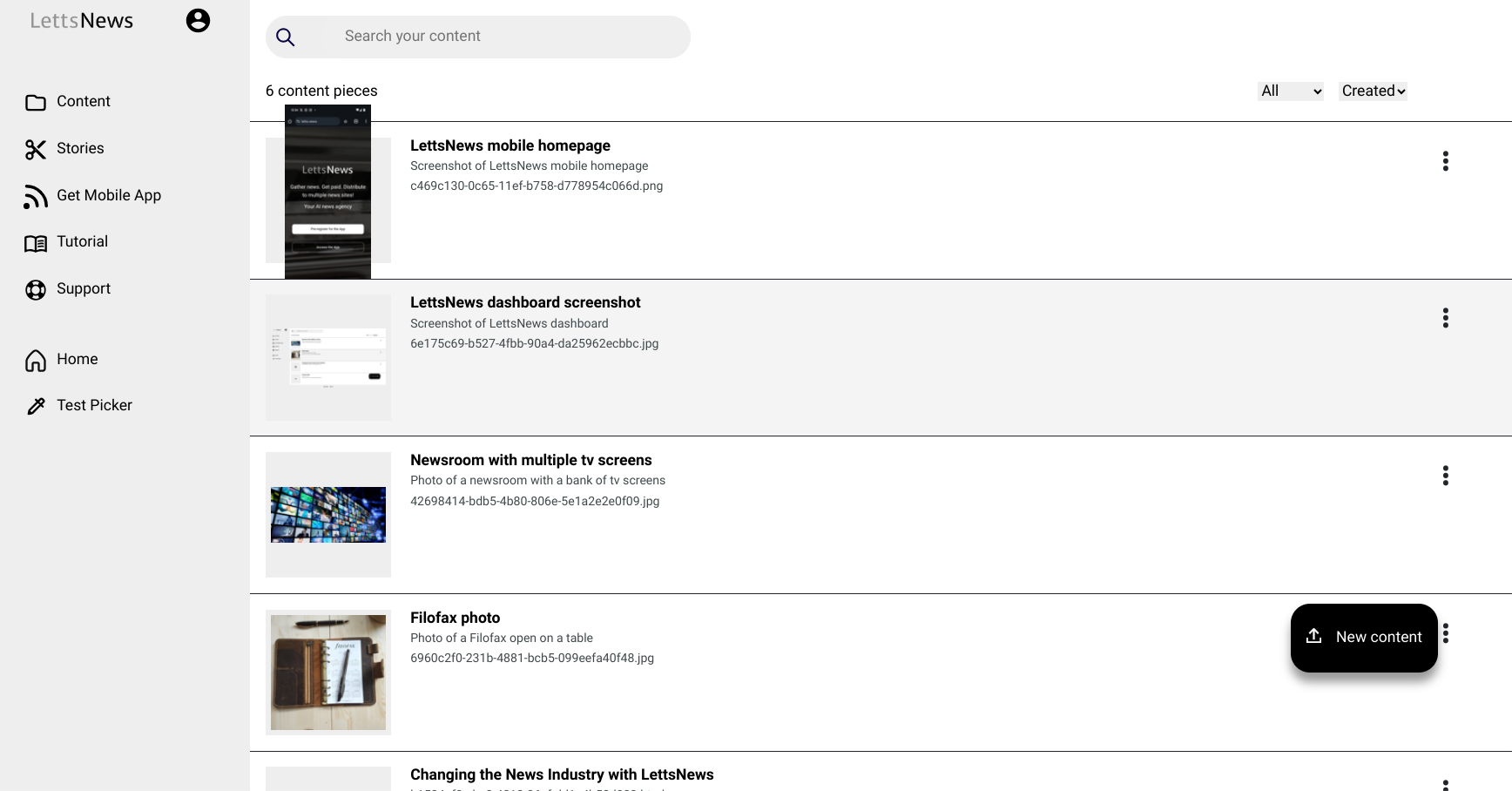
When a news Story is completed it gets filed by the LettsNews system and published ready for auto, one-click distribution to a number of leading news sites, publishers and social media platforms - with more to come. LettsNews users can write once and distribute to multiple different places, including their blog, at the push of a button, doing what used to take many hours in just a few minutes. And Content Items (notes, images, video, or audio) can be re-used any number of times, dragged and dropped into numerous versions of the same story or new stories, leaving more time in the field or office to research, write and work on new stories.
LettsNews plans to add to its V1 offering launched today, introducing advanced AI to speed its system and the process even more, followed by a Content Item marketplace to help creators monetise news items better than before. Their writers and publishers will be able to buy 3rd party news items or clips (text, photo. video, audio) safely, securely and cost effectively - instantly dropping them into their own news stories - while providing a vital new income stream for news creators.
Add this all up and, in a couple of years, LettsNews could become a next generation, crowdsourced and machine-driven news agency for the masses. One fit for this new, fragmented, digital age. Step aside Reuters and Associated Press? We'll keep you posted.
This article first appeared at The Letts Journal.
'Founder Mode' hit Silicon Valley last September like a mini tremor in a fault riddled landscape. You know, the place where San Andreas teeters on the edge... Never quite taking the whole show down - but always there, hanging over the existing status quo. Threatening its very existence. In this case, threatening the essence of traditional management theory.
And it awoke something within our Mothership . After all, we are founders, we've worked with founders and backed founders - and we were one of the early ones to do it. You could argue that 'Founder Mode' is our only mode. We have called it other things, and we have been talking about, writing and developing what is now thought of as 'Founder Mode' for decades... Maybe longer. As a result, we thought it might be time to extend the concept of Founder Mode. You know, take it on a bit - like a jackhammer to the fault line.

Founder Mode is a bigger deal than a few scant searches and a couple of notes might reveal. The term itself was first coined by Paul Graham from Y Combinator. He described a talk by the founder of Airbnb, Brian Chesky, who described getting bad advice from VC's and corporate managers about how to scale his startup. Even business schools seem bereft of management techniques for founders of fast growing, often tech-enabled startups.
Paul Graham's defining article on Founder Mode dug into how founders struggled with traditional school of thought which stated that you should scale your startup by hiring great senior managers (often from large corporations) then leaving them alone to build, manage and lead their function. 8-10 such corporate leaders should be able to run the business for you. Hey, you might even hire a COO to manage them! Except, it seemed, they don't.
Similar sentiments were expressed across the Valley and beyond by founder after founder. And this, following a legion of techniques, systems and training around Manager Mode, first developed during the industrial revolution, by academics, thought leaders and corporate managers. Today 'Manager Mode' is the system, the institution, the accepted norm. Founder Mode versus Manager Mode feels like a very young David versus one massive Goliath. Like Nigel Farage against Elon Musk.
Even Steve Jobs stumbled on the 'Manager Mode' curse. He ended up getting booted out of Apple by his leading corporate manager when Apple was experiencing some scaling challenges. Indeed, the stark differences between Manager Mode and Founder Mode were best revealed by John Sculley (Manager Mode) and Steve Jobs (Founder Mode). Steve Jobs was a product genius, but also a highly instinctive and effective Founder. When he returned to Apple in the 1990's he showed us all how 'Founder Mode' should be done. He had learned his lesson.
But, there have been equally effective founders before him - check Thomas Edison, Walt Disney and Enzo Ferrari. Thomas Edison was an inventor, Walt Disney a cartoonist and animation film producer. Enzo Ferrari was a racing car driver, turned racing car designer and maker. And they all had one thing in common - Founder Mode.

Founder Mode is comparable to 'parent mode' - there is no manual, each child is different, and they grow in their own different ways. The optimal way to bring up a child is to be hands on and deeply involved in their early, first-start (startup?) years. Parents seem to somehow know best and they have a powerful natural instinct for their children's safety, development and health. Like Imelda Marcos and her passion for shoes, except with kids.
But to be a successful parent you have to be a great parent. You have to stay the course and be always on for your child, putting the kid first. Founder Mode is no different. To be a successful founder you have to be a great founder and not just any old founder. You have to stay the course and be always on, putting your startup first. You have to keep shaping and building your product until it breaks through in its market, and you have to know your key customers better than anyone. You have to build a great scaled-up company and a culture where your team is your family.
Founders need to stay nurturing their product and market for as long as they physically can. Deep in the weeds. They should remain hands-on - developing circles of expertise and trusted partners around them. They should manage from the middle, not from some arbitrary office up above with a bunch of corporate yes folk surrounding them (and often failing them).
Structures should remain flat - no hierarchical pyramids. Founders are like a senior trader on a trading floor, with specialist teams around them, and their eyes and fingers on the pulse of any key trade or major moves in the market. Corporate Managers should learn 'Founder Mode' before ever joining a startup or scale-up.
And this trend toward 'Founder Mode' might explain the inexplicable rise of Donald Trump and the coterie of tech titan founders that he is surrounding himself with - just waiting to smash big government like a founder!.
AI and increased automation make Founder Mode more possible than ever. After all, teams can stay small for much longer. A billion dollar company could have less than 20 people - maybe even less than 10 people. Perhaps this is Founder Mode. Perhaps this is the future.
Our Mothership wrote a book about it called 'The Size Zero Handbook'. They plan to serialise aspects of it as they develop a management theory and a set of practices for 'Founder Mode'. We thought you should know. And we welcome anyone who can share their experiences with 'Founder Mode' versus 'Manager Mode'.
In Part 2, coming next Month, we will explore how 'Founder Mode' is developing. Stay tuned - 2025 might usher in a whole new founder led world. God save us!
This post first appeared at The Letts Journal.

As we approach the end of an incredible 2024, it’s the perfect moment to reflect on LettsArt’s journey. This year has been nothing short of transformative, marked by innovation, growth, and connection. Here are six key themes that defined our year:
This year, we achieved unprecedented growth, with the number of online art galleries built using LettsArt surging from less than 100 at the end of 2023 to nearly 800 today. Similarly, the number of artworks hosted on galleries using LettsArt grew to over 3,000. The art industry is starting to pay attention to our more advanced users building expansive, fully featured, new generation galleries. LettsArt's phenomenal expansion underscores the trust and enthusiasm of artists, gallerists, and collectors in the LettsArt platform.
LettsArt introduced several cutting-edge product updates designed to empower artists. From enhanced Art Intelligence (AI) features for creating digital galleries to improved collector engagement tools, our software now offers even more ways for artists and gallerists to showcase their work and build meaningful relationships with their audiences. New features in 2024 included extended support for all art types, multi visual assets for each artwork, text-to-image art creation for digital sketching, modelling and more, usability enhancements, and lately the migration of galleries to a new Web3 platform readying for auto-distribution of art on sale from your LettsArt dashboard to 3rd party digital art marketplaces in 2025. And to get new users up and running faster we created a comprehensive Getting Started Guide.

Building stronger connections between artists and collectors remained a central focus this year. Through our blog and new product features, we emphasised the value of direct engagement and building an active following, fostering a vibrant and interactive community. Indeed many of LettsArt's features drive this and help manage it for you. Our efforts have resulted in deeper relationships and increased support for artists, enabling them to thrive in today’s digital art landscape.
We’ve been proud to expand our network of emerging and independent art professionals using our software across the UK, adding galleries from key regions such as Manchester, Liverpool, Glasgow, Bristol, Devon, Cornwall, and many more. This focus on regional art scenes not only enriches our platform but also provides diverse opportunities for artists and collectors to discover and connect with unique artistic voices.

Through our blogs and articles, LettsArt has positioned itself as a thought leader in the online art industry. Topics ranged from fighting the talent drain crisis to building trust and transparency and the hidden art market . These insights have inspired thousands of users and solidified LettsArt as a go-to resource for navigating the ever-evolving art market.
Community-building was at the heart of everything we did this year. With new Featured Galleries and Featured Art sections we’ve brought together artists, gallerists, and collectors in new and exciting ways. We also kicked off an "Artist in Focus" series ( see the latest on Soft Wasp ) to share interesting artists using LettsArt. The LettsArt community has grown stronger and more connected, with countless success stories emerging from these collaborations. We aim to do even more of this in 2025.

As we look to the future, LettsArt remains committed to driving innovation and growth with its software and emerging community of users, while staying true to our mission of empowering artists and independent gallerists and connecting them with passionate collectors - helping to sell art better. With exciting plans already in motion, we can’t wait to see what the next year will bring.
Thank you to everyone who made this year extraordinary. Here’s to another year of creativity, connection, and inspiration!
In 2024, LettsSafari worked hard to promote rewilding and biodiversity restoration. Our efforts encompassed expanding our rewilding initiatives, engaging our community through educational projects and content, and participating in global environmental movements. And, of course, we were never happier than doing the work on the ground in our very own LettsSafari parks.
Our rewilding safari parks have been developing well, and are making quite an impact. The parks are carefully designed to restore natural habitats, support diverse wildlife populations, and combat climate change. We emphasise a collaborative approach, encouraging public participation in building the parks both physically and with LettsSafari subscriptions that fund tree planting, animal introductions, habitat development and brand new rewilding safari parks.
For every 10 subscribers we plant a 5 year old, naturally grown tree annually, every hundred subscribers support the introduction of new wild animals each year and every 10,000 subscribers we add a whole new safari park a year.

This year we planted more than thirty 5 year old trees across our parks - all grown naturally in LettsSafari's Capability Brown gardens. We created habitats for yet more diverse bird life with our extended waterways and further growth of natural hedgerows. This was the first year that we heard Nightingale in our parks and, at the same time, our birds of prey kept adding to their numbers. Our efforts to protect a resident herd of black fallow deer has been very successful.

One of our network of rewilding safari parks, Hill Crest , sent us their year end update: "All is well here in Devon's wildlands with the Pine Martens released back into our landscape, fledging barn owls and two more sites coming on board this winter, things are coming along nicely." They reminded us of the great words of Dr Seuss, "Unless someone like you cares a whole awful lot, nothing is going to get better. It's not."
Through our direct initiatives, the wider LettsSafari network of parks , our subscribers and our digital outreach, we have inspired hundreds of new rewilding parks and gardens in 2024. We know it because you tell us. Many in southwest England but also now a growing number across the country and even further afield.
Throughout the year, LettsSafari has provided valuable resources to educate the public on rewilding practices. Our "Creating Your Very Own Safari Garden" series offers practical advice for individuals to transform their gardens into wildlife havens, promoting urban biodiversity. Additionally, we've highlighted the importance of participating in initiatives like "No Mow May," encouraging people to let their lawns grow to support pollinators and other wildlife.

In celebration of Earth Day 2024, LettsSafari emphasised the significance of combating plastic pollution and embracing nature restoration. We provided guidance on how individuals can contribute to these efforts, reinforcing the idea that collective small actions can lead to substantial environmental benefits.
Sculptures installed at LettsSafari's Capability Brown gardens in Exeter underlined this - with a series of fascinating trees made by Robert Marshall MRSS from recycled plastic bottles.
Aligning with global environmental movements, LettsSafari participated in World Rewilding Day by showcasing some of the world's most significant rewilding projects. The initiative aimed to raise awareness about large-scale rewilding efforts and inspire individuals and communities to engage in similar activities locally.
LettsSafari was one of the first to develop the concept of urban rewilding. We're excited to see it starting to take off - and in 2024 we highlighted a great number of large institutional projects like the transformation of Derby's Allestree Park into Britain's largest urban rewilding space or the exciting transformation of the moat at the Tower of London. But also photos and description of the many small gardens owned by individuals who have pursued our techniques and created mini rewilded spaces in back gardens or front gardens that line London streets. By highlighting projects, large and small, our advocacy inspires evermore integration of natural habitats within urban settings. It's so important to promote biodiversity even in densely populated areas.

Looking ahead, LettsSafari plans to expand its reach by making its services more universally available. This expansion will involve an even broader audience in rewilding efforts, enabling more people to contribute and benefit from restored natural environments. You never know, we might even pop up in other countries helping them to discover the LettsSafari approach to mass market rewilding - one garden, one park, one plant, and one animal at a time.
Our activities in 2024 have significantly contributed to rewilding and biodiversity restoration - creating a strong platform for growth. Through expanding rewilding parks, providing educational content, and engaging in global environmental initiatives, we are making strides fostering a collaborative approach to environmental conservation, empowering individuals and communities to participate in creating a more biodiverse and sustainable future. We thank you for sharing our journey in 2024 and are excited about doing even more in 2025.
Help us build more rewilding safari parks together in 2025 - subscribe to LettsSafari today.
LettsGroup HQ
2024 has been a transformative year for LettsGroup. Its initial cohort of 5 branded ventures have all launched in their respective markets and the group's groundbreaking AI VentureFactory was released to outside ventures, beyond its own branded ventures. As a result, the group will expand its advisory board in preparation for its ventures moving from startup to scale-up. Advisory board members input to group strategy, as well as guiding and mentoring branded and partner ventures through their stages of growth - we call it co-piloting. With the AI VentureFactory available in limited release to outside ventures, today we announce EAglobal joining the platform. The NewsFlash is extending coverage to this agentic AI company accelerating corporate diligence processes. LettsGroup is getting regularly approached by entrepreneurs and investors interested in signing up to the platform.

LettsCore
LettsCore has made significant progress in 2024, and the next generation Web3 content and media management platform is busy building out its public website in preparation for lower-friction, online customer acquisition and onboarding later in Q1 2025. In December the team continued development of LettsCore's SaaS system with deeper integration of organisational pricing options inside each content atom. They've gained access to Magic Eden api’s and initial work is underway to create a Solana standard NFT Collection and Items, with auto-distribution built in. Following this, LettsCore will add support for OpenSea. The team has built out its integration documentation ready to support their 2nd corporate customer as they will begin work integrating LettsCore into their news publishing system.
LettsNews
The LettsNews team has been focused on making its software available in full public beta from January 2025 . LettsNews delivers simple, yet powerful newsroom tech for journalists, corporate content managers and small and medium media companies. Its private beta has been successfully completed proving its subscription-based web app, supported with fully sync'd mobile apps, is highly effective at rapidly gathering news in-office or in the field, and running the editorial-to-publishing process with team inputs and approvals prior to auto-distribution to leading news sites. Its 2025 roadmap will include auto-posting to social media sites post news distribution, AI enabled headlines, summaries and tags, company subscription plans and development of its news content marketplace in beta.

LettsArt
LettsArt has completed its startup phase, with hundreds of galleries and thousands of users adopting its no-code AI software. It has proven that customers sign up at scale, its product/market fit and early revenues and KPI's - with its early adopter, emerging artist customers wanting to sell art better online with a branded art gallery. From next year the company will scale revenues through higher value customers - both high selling artists, commercial gallerists and art dealers. We highlight one artist that personifies LettsArt's roots with ambitious, emerging artists. Soft Wasp is a post-modern street-style artist using LettsArt's software to build and manage a commercial gallery that sells his art on canvases. There is a certain 'Banksy' about him. His prices are attractive and he is highly prolific. His gallery has 100's of artworks on show and a number available for purchase.
Buy your holiday gifts from LettsGroup ventures: get great art with LettsArt. Subscribe to LettsSafari to get your wild on (once a member you can also gift subscriptions). And now's the time to book your 2025 eco-estate retreat at LettsRetreat. If you're feeling a bit broke after all that subscribe to The Letts Journal - it's FREE!
LettsSafari
LettsSafari is gaining attention as the nascent nature-tech sector begins to form. Its subscription-based digital offering is building a quiet movement around mass market rewilding. Its early adopter subscribers, including nature leaders, green entrepreneurs and influencers are increasingly attracted to its novel approach to eco-services. Word of mouth is extending to the US, Europe and into Africa. Its on the ground action, with its own network of safari parks, its pioneering smaller-scale rewilding system, and its digital, mediatech wrapper is naturally suited to a wide geographic audience focused on nature restoration and rewilding.
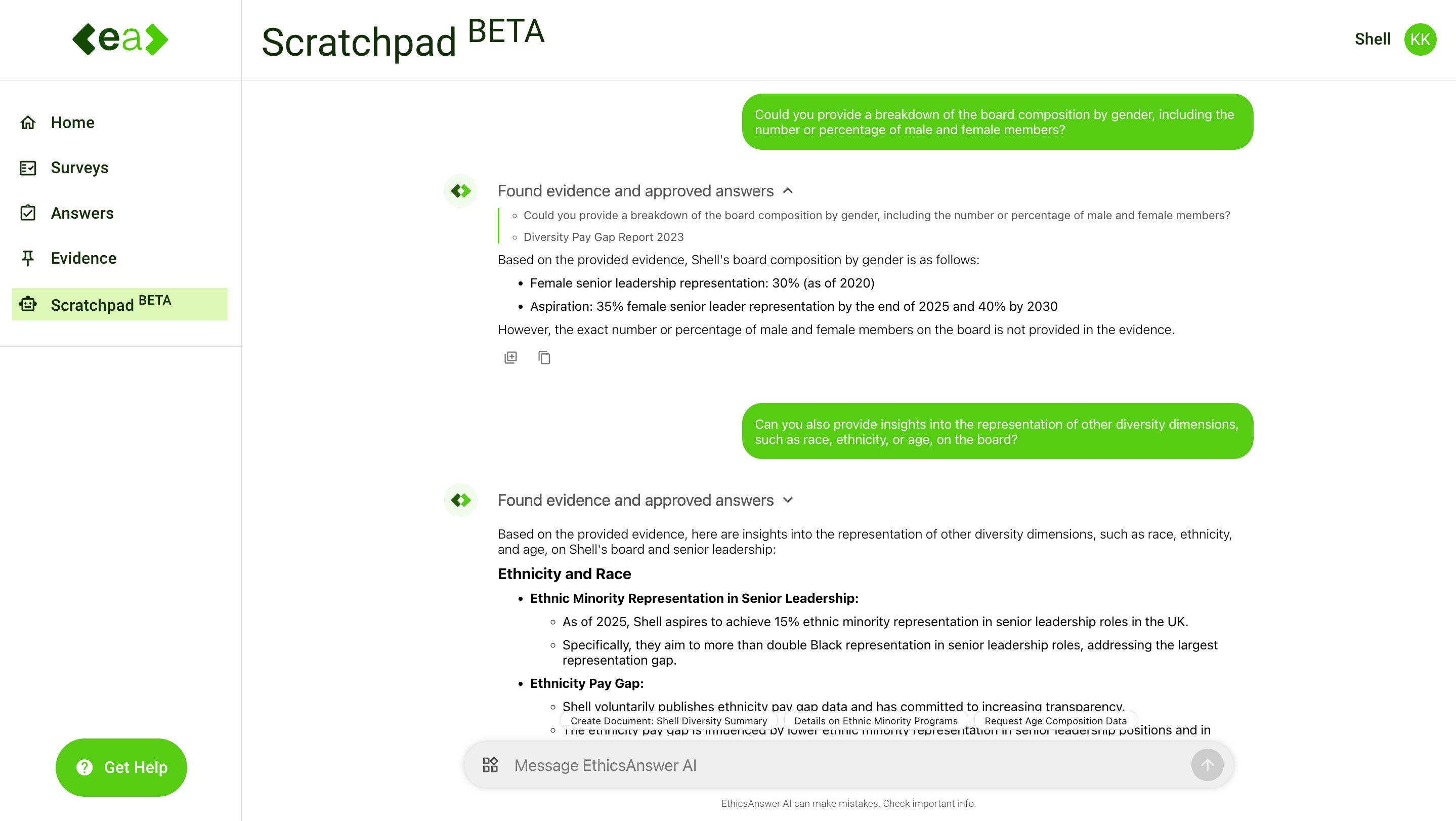
EAglobal
EAglobal is the latest 'partner venture' to have adopted LettsGroup's AI VentureFactory to help it scale-up more efficiently than otherwise possible, which is important given the considerable market interest for its form-filling AI platform that completes diligence questionnaire's (DDQs) regardless of format. The team is led by the ex-head of AI at Fidelity. This UK-based agentic AI company offers its solution to B2B companies receiving DDQ questionnaires from their customers - including ESG disclosures. We're excited to welcome EAglobal to the growing network of LettsGroup ventures - delivering higher venture success rates and better returns.
Other LettsGroup Ventures
We highlight a few of our ventures in each monthly edition of The LettsGroup NewsFlash. To explore other LettsGroup ventures go to LettsGroup/ventures.
The likes of Paul Graham from Y Combinator and Brian Chesky of Airbnb swear by 'Founder Mode'. It's a friendly way to say that corporate managers are crap and founders should trust their control freakish tendencies. After all, it did wonders for Steve Jobs.
At the moment details are a little sketchy other than 'ditch the corporate mumbo-jumbo jargon folk'! You know, the empty suits with Adidas Campus sneakers - and manage from the middle (we added that) with tonnes of reports and control. Do what your gut tells you, just not the Sam Bankman-Fried kinda gut.
The Mafia have apparently been practising 'Founder Mode' for ages. They call it 'keeping it in the family'...

This cartoon first appeared at The Letts Journal.
LettsGroup HQ
A month after LettsGroup launched its AI VentureFactory to a wider audience it has already started onboarding 3rd party ventures. Its hybrid-AI approach, its software suite for early stage tech-driven companies and the approach to co-piloted 'startup intelligence' is clearly appealing. LettsGroup is excited to bring its unique approach to system-driven scaling and automated demand creation to more entrepreneurs. A number of entrepreneurs and investors have registered , even while the AI VentureFactory is in limited release. From a technology perspective the team has been developing automated connectors between widgets, processes, commands and end-apps to further extend its AI driven automation. Watch this space.
LettsCore
As LettsCore starts the planning to onboard its 2nd corporate customer, the Media-as-a-Service platform has been busy extending its technology further, including organisational management - invite / edit / remove users to organisations, plus adding content atom pricing support for media owners, enabling a single billing account to manage the purchase of content by any user within the organisation. This functionality includes the full range of pricing/monetisation options, with perpetual and per-use based pricing fully integrated to the user's wallet. The team has been researching auto-distribution of NFT content directly into NFT market places. Magic Eden and OpenSea will be first up. Also, LettsCore's web based customer onboarding system is nearing completion for wider roll-out in Q1 2025.
Buy your holiday gifts from LettsGroup ventures: get great art with LettsArt . Subscribe to LettsSafari to get your wild on (once a member you can also gift subscriptions). And now's the time to book your 2025 eco-estate retreat at LettsRetreat . If you're feeling a bit broke after all that subscribe to The Letts Journal - it's FREE!

LettsNews
LettsNews has nearly completed V1 ready for full beta release in January. The team have worked hard to complete the functionality necessary to get its simple, yet powerful newsroom tech to freelancers and SME's, with software that automates the process from news gathering, story development, tagging, search, virtual team collaboration and approvals through to filing, publishing, archiving and auto news distribution. The roadmap for V2 has been mapped out, to include AI news creation, tagging, AI connectors, advanced search, AI 'Content Item' suggestions, an enterprise subscription plan and a groundbreaking news item marketplace. Users can register for LettsNews beta release with its web app synced to the mobile app to be released on the Google Play Store and App Store by January.
LettsArt
LettsArt had a stellar month in November, with 2 new art galleries a day signing up to its no-code AI software platform (just 12 months after its soft launch). LettsArt is heading towards 800 artists and gallerists using its software to manage, distribute and sell art. Early subscription and transaction revenues are shaping and the art available at galleries using LettsArt is increasingly diverse and appealing - with multiple price points. Its nearly 2,500 users are becoming a valuable engine for viral, organic growth enabling LettsArt to scale efficiently. Hundreds of artworks were added to LettsArt galleries last week alone. In early 2025 LettsArt will deliver auto-distribution of NFTart from its dashboard to other leading NFT marketplaces. It has become the most advanced software to fully support any kinds of art - both physical and digital.

LettsSafari & LettsRetreat
LettsSafari has just kicked off its first digital advertising campaign for climate enthusiasts to subscribe to its platform. Being National Tree Week, LettsSafari has been running a series to educate its subscribers about planting and nurturing trees for wildlife. Next week the team will spend 4 days in its parks planting out new trees - a mix of deciduous 5 year old trees grown in designated areas in LettsSafari parks using their rewilding system. Meanwhile, LettsRetreat is gearing up for a busy Christmas and early bookings for company retreats and stays in 2025.
Other LettsGroup Ventures
We highlight a few of our ventures in each monthly edition of The LettsGroup NewsFlash. To explore other LettsGroup ventures go to LettsGroup/ventures.
Here are the top 5 ways that LettsArt's AI can help you better show and sell art online:
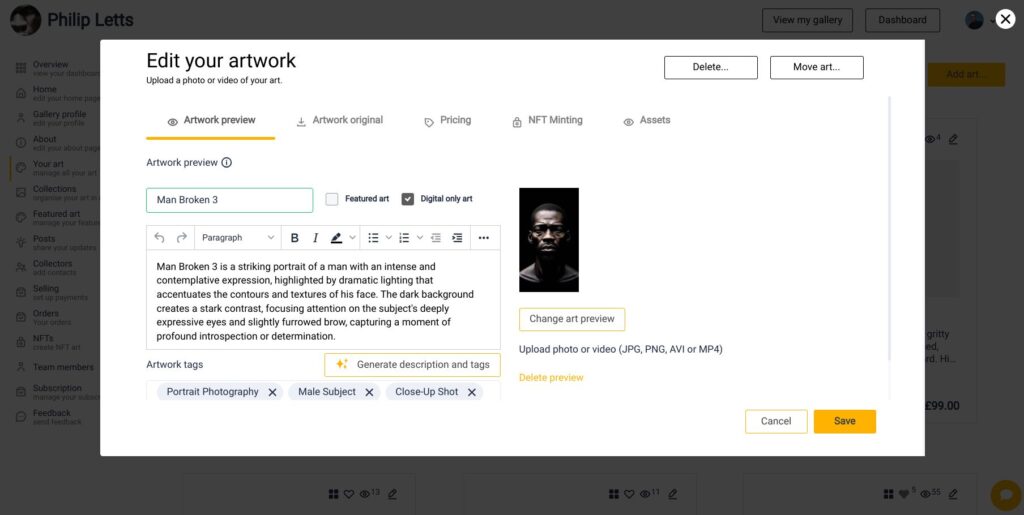
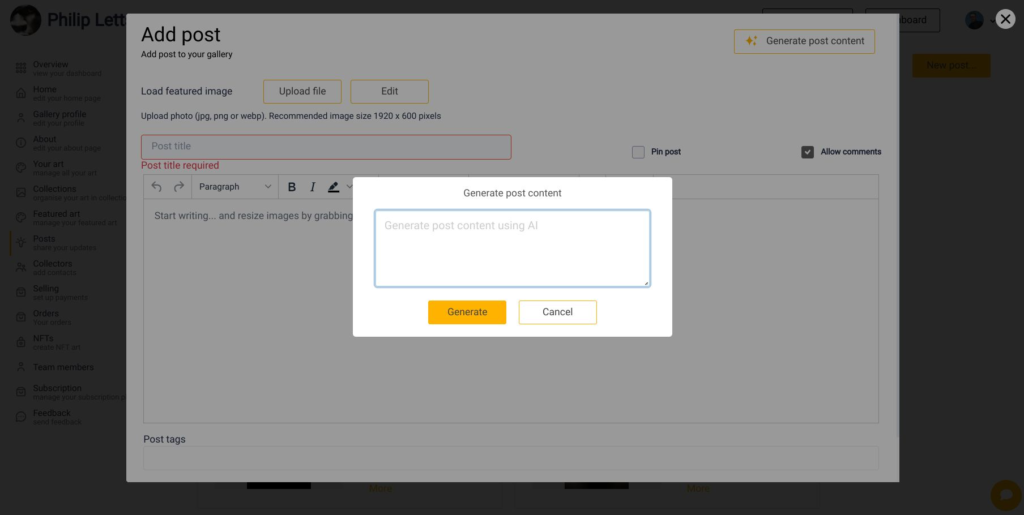
LettsArt's no-code software enables any artist, gallerist or art dealer to better show and sell art online. LettsArt AI gives you the extra edge - delivering 'art intelligence'.
To sign up to LettsArt go to www.LettsArt.com.
LettsGroup HQ
In October LettsGroup's AI VentureFactory was offered in limited release to select 3rd party startups, scale-ups and corporate incubators. Already utilised by LettsGroup's own branded ventures, the AI VentureFactory is now ready to co-pilot outside companies. Its startup methodology, venture building tools and processes, are proven over many years and with multiple tech-driven startups. It can transform both innovation delivery and financing - doubling venture success rates while considerably enhancing returns. Businesses beyond Seed investment and venture backers can register at https://letts.group/register/. Also this month the team has been expanding its software suite with investor management and comms capabilities. Next up is transactional extensions which will provide interesting new opportunities for entrepreneurs and investors.
LettsCore
LettsCore's tech team have been working on its content monetisation and customer subscription system as it moves to wider commercial release, developing subscription plans (partnering with Stripe), and setting pricing contracts for each piece of content - both perpetual licenses and pay per view contracts. These are working nicely - particularly pay per view which decrements wallet balances in real time as content is viewed. This opens up opportunities for content owners and creators to offer their content to AI LLM learning engines, that can be charged each time the content is utilised in the learning process. November will be finalising the UX flow for the SaaS front end and developing the approach to NFT auto-distribution onto 3rd party marketplaces. At the same time, LettsCore's first corporate customer is expanding its roll-out while the blockchain-based distributed media platform is getting ready to onboard its second corporate customer.
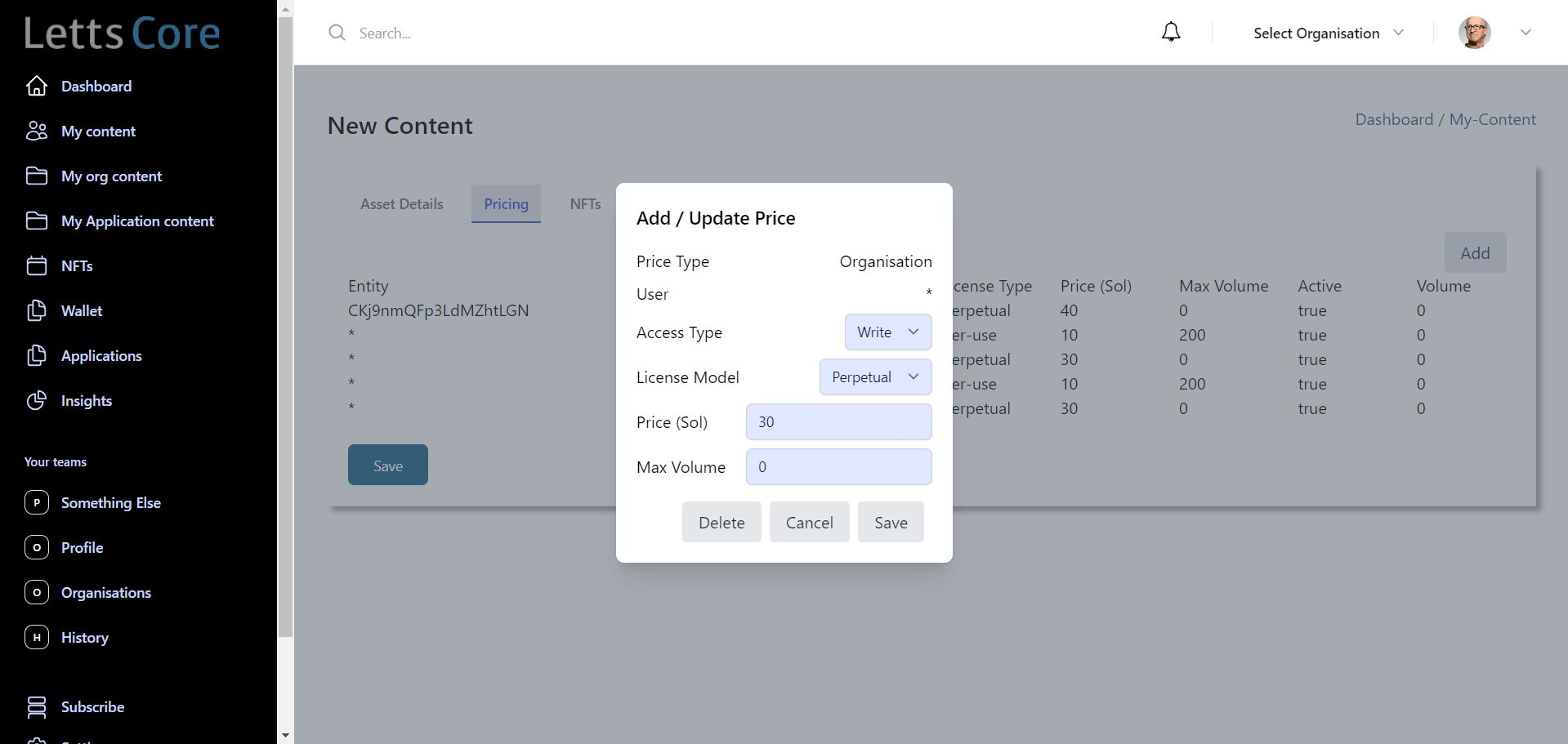
LettsNews
LettsNews is also busy readying for wider beta release to targeted journalists, corporate comms and PR firms. The team is getting its mobile app ready for wider release into the Google Play and Apple App stores while enhancing the web app. Over the last 6 months the private beta has delivered enough feedback to build a robust commercial V1 offering earlier than expected. The way in which LettsNews handles the news content process from gathering news, to publishing and auto-distribution is both highly efficient and innovative. The Team functionality links this process from corporate content managers to PR's and selected journalists and news publishers which can drive significant efficiencies across the industry. The next leg of the product to V2 will deliver AI enhancements and content monetisation with a news item content store. The combination could prove to be quite pivotal for its users.
LettsArt
LettsArt has approaching 700 art and artist galleries using its no-code AI platform with over 2,000 users in total. Various enhancements across its AI capabilities and art community features mean that LettsArt V2 is now ready for prime time - going from startup to scale-up and into Stage 4 of LettsGroup's venture building methodology Innov@te. In preparation, LettsArt has developed an algorithm to highlight some of its featured gallery users and is also readying for a mixed-gallery display of featured art from some of its leading gallery customers.
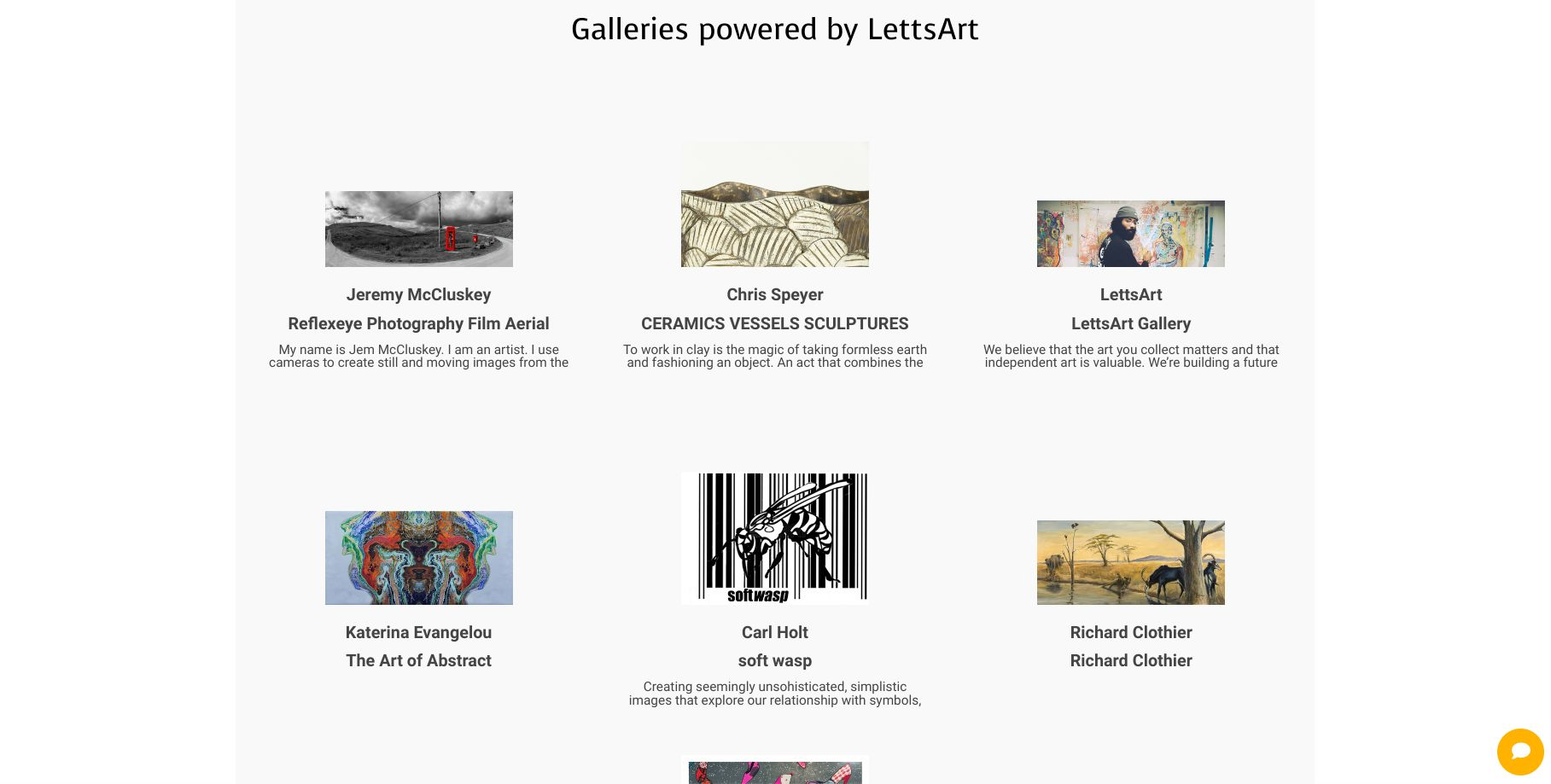
LettsSafari and LettsRetreat
LettsGroup's two emerging eco ventures have made solid strides in October. LettsSafari has just kicked off its first digital ad campaign expanding its paid subscribers and commercial KPI's in advance of wider market expansion later in 2025. It has started working with Wimbledon Park, amongst others, to develop a network for historic tree seed banks across the UK with other well known parks. LettsRetreat has just launched an innovative subscription membership programme ideally suited for organisations interested in eco retreats for their teams and as incentives for top performing employees. Members can subscribe to eco retreat stays for 5 days a year for teams up to 14 people at just £399 per month - find out more here.
Other LettsGroup Ventures
We highlight a few of our ventures in each monthly edition of The LettsGroup NewsFlash. To explore other LettsGroup ventures go to LettsGroup/ventures.